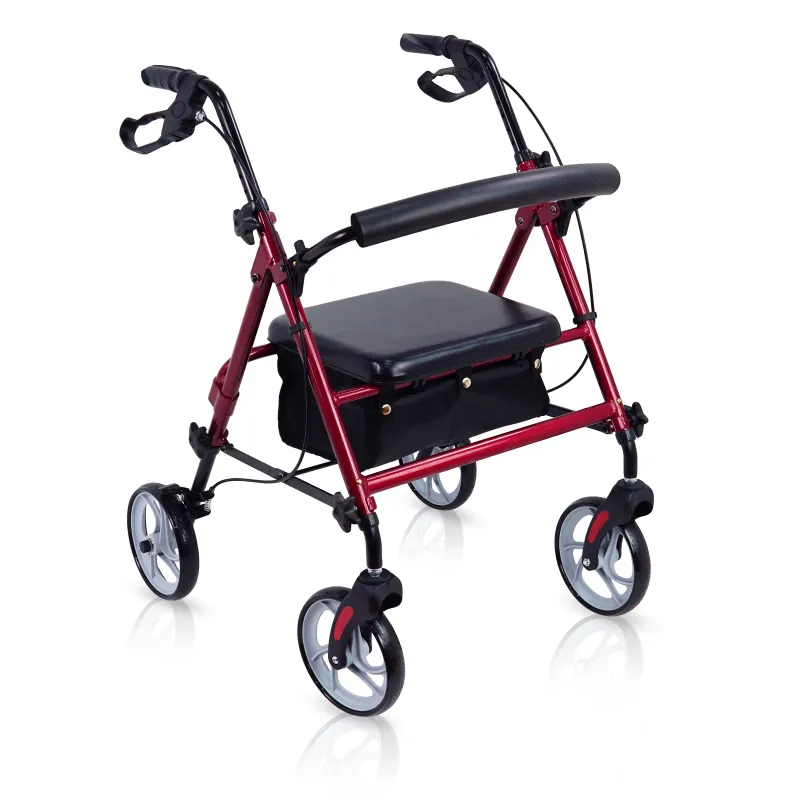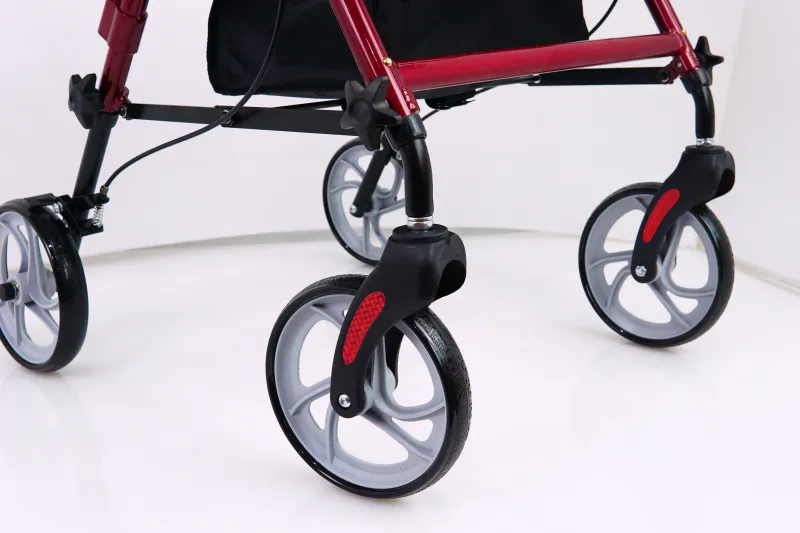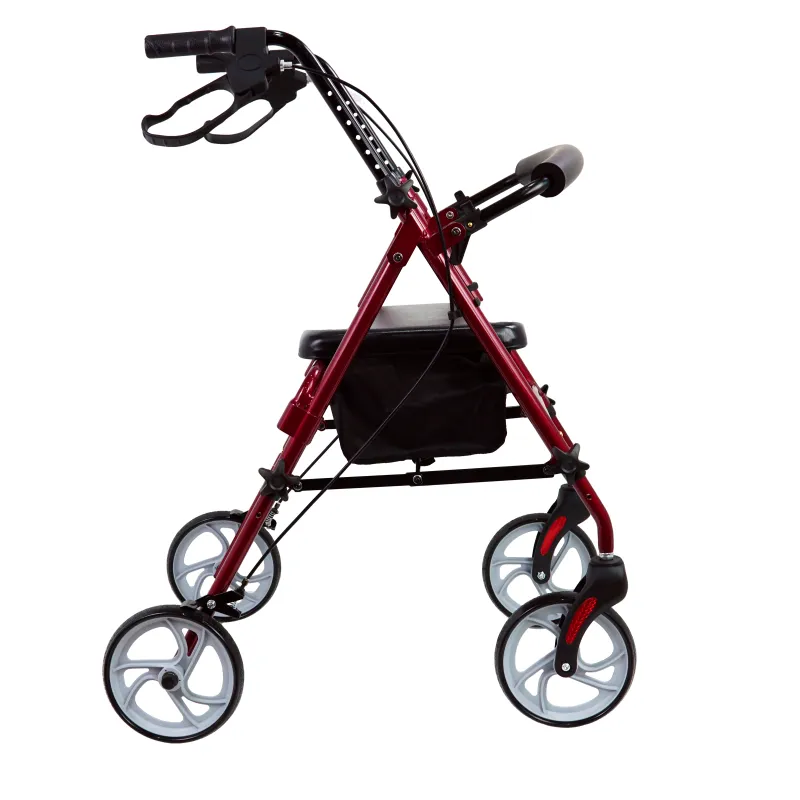
Are wheeled rollator walkers safe for the elderly?
2024-08-14 15:30
Rollator walkers with wheels are a widely used assistive device to help the elderly walk. They are designed to increase the independence and freedom of movement of people with limited mobility while reducing the risk of falls.
However, are wheeled rollator walkers truly safe? Will they cause slips during use? This article will explore these issues in depth and provide relevant usage recommendations.

What is a wheeled rollator walker?
Rollator walkers with wheels usually consist of a frame, four wheels, a seat and a storage basket, and some models are also equipped with a brake system. Its main function is to provide support for elderly people with difficulty walking and help them maintain balance when moving around at home or outdoors. Compared with traditional walkers, wheeled rollator walkers are more flexible and can greatly reduce the physical burden on users.

Safety analysis of wheeled rollator walkers
1. Advantages of wheeled rollator walkers:
● Stability: Modern wheeled rollator walkers are designed with stability in mind. The four wheels can provide good support and users can get a stable sense of balance when walking.
● Flexibility: The presence of wheels makes the rollator walker more flexible when moving, and it can easily turn and adjust the direction. This is a great convenience for the elderly with limited mobility.
● Reduce physical burden: When using a rollator walker with wheels, the elderly do not need to lift the walker, but only need to push it forward, which greatly reduces the physical burden, especially for those with weak strength or joint problems.
● Versatility: Rollator walkers with wheels are usually equipped with seats and storage baskets, so that the elderly can sit down and rest at any time when they are tired of walking, or carry shopping items, which further improves the convenience of daily life.
2. Potential risks of rollator walkers with wheels:
● Risk of slipping: Although the design with wheels increases flexibility, it also brings the potential risk of slipping. If the user uses the rollator walker on a downhill or slippery ground, the wheels may slide too fast and cause loss of control.
● Braking system: The braking system is an important part of ensuring safety, but not all elderly people are proficient in using the brakes. Some elderly people may not be able to brake in time in an emergency, resulting in accidental slips.
● Uneven ground: On uneven or obstacle-filled ground, a rollator walker with wheels may cause the user to lose balance due to wheel jamming or bumps.

Recommendations for using a rollator walker with wheels
1. How to choose a suitable rollator walker with wheels:
● Stability and durability: Choose a rollator walker with reliable quality and sturdy structure. Check its material and wheel design to ensure that it can provide good support under different ground conditions.
● Braking system: Choose a rollator walker equipped with an efficient braking system. It is best to have a double-hand brake design, which can adjust the speed at any time while walking and provide sufficient braking force when stopping is required.
● Height adjustable: Choose a rollator walker with adjustable height to ensure that it can adapt to users of different heights and enable the elderly to maintain a natural standing posture when using it.
● Seat and storage function: Choose a rollator walker with a comfortable seat and storage basket to provide more convenience and functions.
2. Correct use method:
● Learn to use brakes: Before using a rollator walker with wheels, the elderly should learn how to use brakes correctly under the guidance of professionals. Mastering braking skills is the key to ensuring safety.
● Choose a suitable use environment: Try to use the rollator walker on flat and dry ground, and avoid using it in slippery or steep places. If you must use it in these places, you should be extra careful, adjust the speed and be ready to brake at any time.
● Regular inspection: Regularly check the various parts of the rollator walker, including wheels, brake system, seat and storage basket, to ensure that they are in good condition. If problems are found, they should be repaired or replaced in time.
● Correct posture: When using a rollator walker, the elderly should maintain a natural standing posture, hold the handrails lightly with both hands, and do not lean too much on the rollator walker. This can effectively prevent loss of balance.

Case analysis of the rollator walker with wheels
1. Successful cases:
Grandma Li, 75 years old, has difficulty in moving due to leg joint problems. Since using the rollator walker with wheels, she can go to the nearby park for a walk alone and go shopping in the supermarket by herself. Grandma Li said that the design of the seat and storage basket of the rollator walker makes her life more convenient. Whenever she is tired, she can sit down and rest at any time.
2. Risk cases:
Grandpa Zhang, 80 years old, was using a rollator walker with wheels to go out after a rain. Because the ground was slippery, the rollator walker suddenly slid too fast, causing him to lose balance and fall. Fortunately, Grandpa Zhang only suffered minor injuries, but this accident reminded him and his family to be more cautious when choosing the environment for use.
3. Expert opinion:
Rehabilitation expert Dr. Wang pointed out that the rollator walker with wheels is a very useful tool for the elderly, but the premise is to choose and use it correctly. Dr. Wang suggested that the elderly should consult professionals when purchasing a rollator walker and choose the appropriate model according to their physical condition and use environment. At the same time, special attention should be paid to safety details during use, such as learning to use brakes and avoiding use on unsuitable surfaces.








